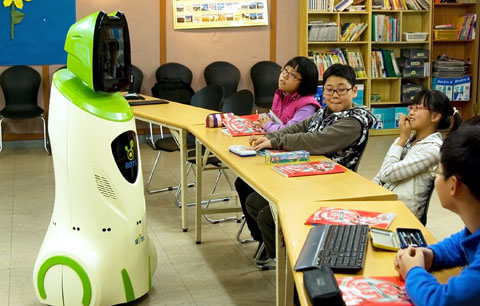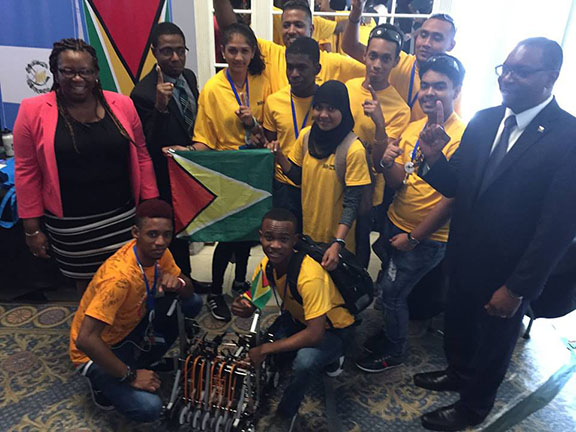The role that robots can play in opening up new avenues in the field of education – perhaps in a manner similar to that played by digital technology a few years ago – stands, arguably, on the threshold of the agenda for debate and discussion as part of the wider discourse of curriculum change and education development in Guyana. The avenue for this discourse has been paved by the advent, a few years ago, of the group STEM Guyana and much later by the more recent announcement by the Ministry of Education of its intention to introduce robotics as a discipline in the local school system.
It is no longer a question of determining whether or not robotics is what one might call ‘relevant technology’ at this stage of Guyana’s development. The facts speak for themselves. Our contemporary economic/developmental pursuits are becoming inextricably bound up with robotics. This is certainly the case with the oil and gas sector, a sector which, for the foreseeable future, looms large in the development of the country. Accordingly, we must begin to discuss robotics as a stimulating and strategically significant topic as part of the broader issue of the growth and development of Guyana.
The advent of STEM Guyana just a few years ago and the successful participation of a team from Guyana in a 2017 international robotics competition triggered a significantly enhanced awareness of robotics among Guyanese in both the formal and informal teaching and learning systems. There developed limited pockets of discourse regarding the desirability or otherwise of incorporating robotics into education if only for the purpose of creating an enhanced interest in Science, Technology, Engineering and Mathematics (STEM) or as an instrument with which to open the way for children towards a society in which robotics will be consistently integrated everywhere.

While the jury would appear to be still out on that issue, the role that STEM Guyana has played in popularising robotics in communities in several parts of Guyana coupled with the Ministry of Education’s expressed interest in inserting robotics into the curriculum point to the reality that robotics has become part of the national discourse in the broader discussion on the relevant development in our education system.
What it seems is yet to emerge, is a collaborative initiative that binds the pursuits of STEM Guyana and the formal education system along with the various other technologically-focused institutions if Guyana is to enable a speaking with one voice and a pooling of what are still limited resources to get the robotics show on the road…so to speak. It is this bringing together of the opinions and visions of stakeholders from educational institutions and tech savvy organisations which, ultimately, will lead to a realisation of that goal.

Our own admittedly limited research on robotics and education has turned up revelations arising out of the pursuits of Robotics, South Korea’s leading Educational Robotics company which asserts that “robotics is the best tool for Project Based Learning (PBL) for the 21st century and the most exciting way to learn by doing.” The view further asserts that “PBL is a student-centered pedagogy that involves a dynamic classroom approach in which students acquire deeper knowledge through active exploration of real-world challenges and problems. Students learn about a subject by working for an extended period of time to investigate and respond to a complex question, challenge or problem.”
The robot as what one might call “an educational subject” is applied elsewhere in early primary classes among children as young as 5-6 years of age, enabling them to learn basic algorithms by programming objects and actions. During their later schooling they are exposed to competitions at different levels using robots they have built and programmed.
Robots also help to support broader educational activities in disciplines like health education where simulation is an important vehicle for learning to improve health care management. Implementation of effective teaching methodologies in the health sector rely increasingly on robotic simulators.
Many developed countries have implemented the widespread use of tele-presence robots, devices that enable sick children to benefit from out-of-classroom sessions school by through tele-operated robots.
These roles apart, robotics can also assist teachers in their pursuits by performing some types of classroom management functions like accounting for the presence or absence of students and welcoming them into the classroom by name. This facility enables the teacher to maintain his/her pedagogical focus.
Among the well-researched conclusions regarding the relevance of robots and robotics as part of the schools’ curriculum is their role in:
● strengthening scientific and technological culture in
schools;
● facilitating the transfer of knowledge through
trans- disciplinary activity- based projects;
● Serving as tools for the application of scientific
thinking;
● Deployment as artefacts for rendering abstract
knowledge concrete, that is to say, for teaching
real- world application of math, science,
programming and engineering.
As a means of contributing to the fight against school failure, robots also enable project-based teaching, and change the learning environment by making it more flexible and less stigmatising, especially for students experiencing difficulties,
Those countries that have been successful in making robotics an integral part of their education system are useful examples to follow. In South Korea, for example, the introduction of an ambitious educational robotics programme led to the placement of more than 3,000 robots in pre-schools. South Korea’s national robotics strategy has triggered the development of educational robotics companies that lead the field globally. South Korea also hosts a number of after-class robotics programmes and competitions for children.
One decisive factor for ensuring the success of educational robotics is involving teachers. Teachers can help to identify clear learning outcomes, aims and objectives for educational robotics so that it is proven truly useful in schools.
Many traditional topics too can be taught by ‘stealth’ using robotics. Literature on the subject indicates that “light and reflection can be covered by programming line-following robots, or with ‘table-top dancers’, robots that move around a table without falling off the edge. Students can learn about the movement of a pendulum, or use data-logging tools to measure body temperature change while a student exercises. Human movement can be studied by examining the capabilities of a robotic arm, or by developing a walking robot. Data-logging tools and counters mean that reaction times, vehicle acceleration, and distances covered by a vehicle in a set amount of time can be recorded, graphed, or used for predictions.”
Robotics can also be used to generate group activities, and for problem-solving and logic-based activities. What is known as “the learner-centred approach of robotics education” also allows for open-ended teaching and learning outcomes.
Several aspects of the research for this feature drew on an article authored by Ian Maud, St Paul’s Anglican Grammar School, Victoria and Chairman of RoboCup Junior Australia. Reprinted from The Curriculum Leadership Journal





